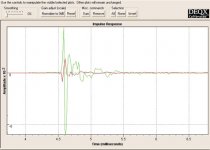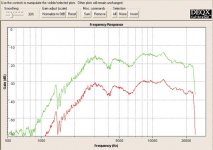I don't know if this is the right forum for this message. It could also be in a tube vs transistor topic or whatever, but afterall it's about loudspeakers so I'll just post it here.
Today I have made some tweeter measurements on a couple of old type ESS AMT transformers (the small ones on a round baffle)
I did some frequency and impulse response measurements on them using two different amplifiers. One was a Hiraga 20W class A transistor push pull amp, the other one was a 300B single ended triode amp (mu-stage driven)
As you can see there is almost absolutly no difference in the frequency response measurements (one is scaled for better view) but the impulse response show a big difference. The green line is the one with the Hiraga amp the red one with the 300B amp (notice that this one is out of phase)
The transistor amp seems to have a much faster rise time but also has some more "ringing", draw your own conclusions here.
I haven't done a extensive listening test to actually hear the difference, gonna do that soon.
so here's the measured impulse response
Today I have made some tweeter measurements on a couple of old type ESS AMT transformers (the small ones on a round baffle)
I did some frequency and impulse response measurements on them using two different amplifiers. One was a Hiraga 20W class A transistor push pull amp, the other one was a 300B single ended triode amp (mu-stage driven)
As you can see there is almost absolutly no difference in the frequency response measurements (one is scaled for better view) but the impulse response show a big difference. The green line is the one with the Hiraga amp the red one with the 300B amp (notice that this one is out of phase)
The transistor amp seems to have a much faster rise time but also has some more "ringing", draw your own conclusions here.
I haven't done a extensive listening test to actually hear the difference, gonna do that soon.
so here's the measured impulse response
Attachments
I'm not sure they are so different other than the reversed polarity. If you turn the 300B up so the volume is the same, and the amplitude of the big impulse spike is the same, I'll bet the "ringing" looks similar too.
they actually are measured at the same volume, the red curve is only scaled down for better visabilty.
One amp appears to be inverting the input signal. If you multiply one of the impulse responses by -1, and scale the first peaks to be the same magnitude for both traces, I would guess that the impulse responses would look much closer to being the same.
I don't know how your system works, but the two I've used ratio the raw SPL spectrum against the applied voltage spectrum, which takes the amp frequency response out of the picture.
Guess you guys are right. I scaled the frequency response back and know the impulse response looks almost identical. I made a mistake by first scaling the frequency response before comparing the impulse responses, stupid stupid stupid, please excuse me.
Anyway, I'm gonna be listening to the difference this week to see (hear) what's comes out.
Anyway, I'm gonna be listening to the difference this week to see (hear) what's comes out.
- Status
- Not open for further replies.
- Home
- Loudspeakers
- Multi-Way
- Impulse response differences

